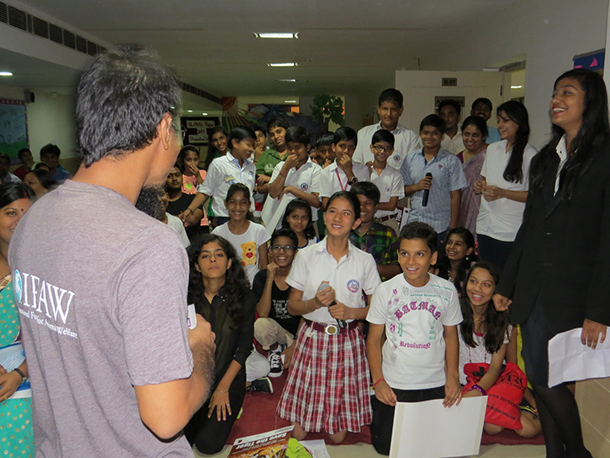In the creation of tiger messengers, change begins now
By:
Sheren Shrestha
Manager- Animal Action Education, Awareness for Conservation
New Delhi, September 3, 2014: Children are the key to the future of our wildlife. They can also be the present.
Our Animal Action Education programme team in India was recently invited to give a talk on tigers at a school in the National Capital Region to be a part of their Global Tiger Day celebrations.
We had a hidden motive though.
We did not want to just talk about tigers. We wanted the students to become messengers for tigers and other wildlife of India. To tap this force and start a chain reaction, and take the message from what they learned to their friends and family, and beyond.
So, there we were on Saturday morning, Dr Mayukh Chatterjee, Achintya Tripathi and I.
There were about 100 of them, students and their parents, as well as the teachers of Meenakshi Public School in the National Capital Region. Very few of them had seen tigers; fewer still had sighted them in the wild. However, they were eager to learn and their enthusiasm was inspiring.
We began with introductions – about the tiger and ourselves. We asked questions and solicited answers from the audience, rewarding both correct and incorrect answers. The point, after all, was not competition, but a session to learn and motivate.
We then screened our AAE documentary ‘Born to be Wild: Saving the majestic Tiger’, and followed that up with a quiz. We asked the audience about tigers and their behaviour. Following the correct answer, we held a little discussion on the question to help them understand the issue better.
Then it was time for the students to question us. It wasn’t as easy as we thought it would be.
How many stripes does a tiger have? Why does India have Royal Bengal tiger and not other species? How big is the biggest tiger? Can tigers live in the desert? Why are poachers given bail when the government knows that they will kill more tigers?
And on and on, till the coordinating teachers announced that we had run out of time. Some of these questions were cute! Others amazed us, or made us realise that there was hope.
One question that I found particularly striking, in its simplicity and yet its depth, was: “Why are we unable to save the tiger?”
Despite only a few thousand remaining in the wild, the visible focus on the species, the values it holds for the ecosystem, and despite them being our national animal, tigers are being killed. It was incomprehensible to this young mind that we let this happen.
There was only one answer we could give: “There are very few of us trying.”
In a country as complex and populous as India is, there are, and will continue to be, difficulties and challenges. However, looking at the bright side, we also have the opportunity of creating a bigger force for our natural heritage.
“Join us. Become the voices of the tigers, become their messengers…” we said.
The ensuing silence indicated that it had sunk in.
The session ended with a loud resounding “Let’s save the tiger!” with a clearly charged group of students – now messengers for the tiger.
These children represent the future but they also represent a change that begins now.










